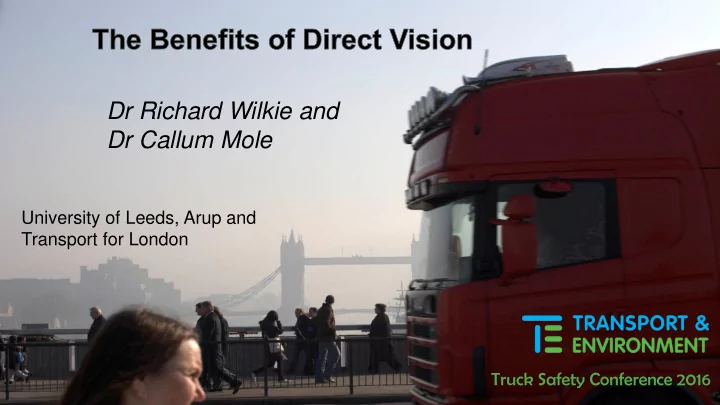

Dr Richard Wilkie and Dr Callum Mole University of Leeds, Arup and Transport for London Truck Safety Conference 2016
Accident Statistics In the EU 4,254 people died in collisions involving heavy goods vehicles (HGVs) in 2011 28% of road deaths following HGV collisions were Vulnerable Road Users 15% pedestrians 7% cyclists 6% powered two-wheeled vehicles
Project Purpose & Aims • There are currently NO research studies examining whether Direct Vision of vulnerable road users could improve road safety. • OUR MAIN QUESTION: Does Direct Vision (windows) enhance road safety compared to Indirect Vision (mirrors) ?
Vision is critically important when driving! Low-entry Cab Traditional Cab Direct Indirect
Mirror Image Mirrors provide useful visual information not directly visible to drivers. However, there are potential safety issues: Our Focus Reflected objects Recognition rates Mirrors can distort may be overlooked compromised near reflected objects compared to direct mirror edges objects View can be Mirrors may be set influenced by up incorrectly, elements such as impairing coverage rain and dirt
Our Research Three ongoing experiments : 1. Reacting to Visual Objects • Direct vision – via windscreen • Indirect vision – via mirrors 2. Driving and Braking • Traditional vs. Low-entry cab 3. Added Cognitive Load • Reacting to Visual Objects • Traditional vs. Low-entry cab
Laboratory Set-up: Virtual City Driving
Laboratory Set-up: Mirror positioning
Task Design: High Visibility High Visibility
Task Design: Low Visibility Low Visibility
Task Design: Pedestrian Pedestrian
Experiment 1: Reaction Times The results showed that direct vision responses were on average 0.7s faster than indirect vision. RT doubled
What would this delay mean? At slow (15mph) driving speeds this would cause 4.7m of extra travel before braking. At 5mph (pulling off speed) this still equates to 1.5m extra travel. These distances are more than enough to collide with a pedestrian in front of the vehicle. Speed Extra Travel 15mph (24km/h) 4.7 m 10mph (16km/h) 3.1 m 5mph (8km/h) 1.5 m
Experiment 2: Pedestrian Collisions To assess if slower Reaction Times in Experiment 1 would lead to more collisions, we examined driving when pedestrians crossed the road in front of the vehicle. Indirect Traditional cab Low-entry cab Direct
Experiment 2: Pedestrian Collisions We analysed driving when pedestrians crossed the road in front of either a Low- entry cab or Traditional cab. Do slower Reaction Times mean more collisions in city driving? % DRIVERS COLLIDING Yes. The Traditional cab increased incidence of pedestrian collision by 23%. Low Traditional Entry
Experiment 3: Added Cognitive Load Drivers usually perform other tasks when driving that can be distracting. Experiment 3 examined the impact of a concurrent task on Reaction Times and Collisions. As previously Direct and Indirect vision (or Traditional/Low-entry cab) conditions were examined independently. Respond when BOTH numbers odd
Experiment 3: Added Cognitive Load
Experiment 3: Added Cognitive Load Does cognitive load slow Reaction Times? Yes. Cognitive load slowed Reaction Times by an additional 0.5 seconds (for both Direct and Indirect vision) +0.5s
Experiment 3: Added Cognitive Load Does cognitive load impact on collisions? Yes. Proportion of drivers colliding with pedestrians increased by 40% in the Traditional cab when cognitively loaded % DRIVERS COLLIDING Low Entry Traditional No Cog Cog (Exp.2) (Exp.3)
Summary of Findings Potential but undetermined causes Objects /VRUs overlooked in mirrors Indirect Vision 1.5 m increased Potential (via mirrors 0.7 sec slower distance prior to increased 23% as opposed to reaction time braking likelihood of windows ) (at 5 mph ) collision Gaze and/or attention toward likeliho road collis 1.1 m increased Potential 0.5 sec slower distance prior to 40% increased Cognitive Load braking reaction time likelihood of (at 5 mph) collision
Further Details Funded by: • These are preliminary research findings • End of project report submitted to TfL 14/10/2016 In collaboration with:
Recommend
More recommend